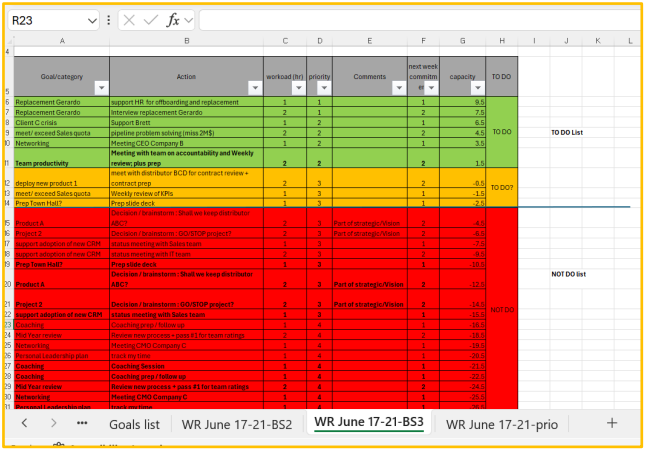Weekly Review
Habit card
Click on the box
Download your free products
Download your free products
Click on the box
Click on the box
Weekly Review
Advice on setting realistic and achievable goals, even in high-pressure environments.
Overcoming Anxiety at Work
Summary: Strategies for reducing workplace anxiety and creating a secure environment for all employees
Main Outcome: Reduced workplace anxiety
Top Benefit(s): Improved overall mental health and productivity
Next Steps: Implement stress-reduction techniques and monitor their effectiveness
Time to Complete: 30 minutes
Target Audience: All employees, Mental health advocates
 Why it works
Why it works 
- A weekly review is one of the most powerful habits for staying on track with your goals, reducing overwhelm, and ensuring continuous progress. Without regular reflection and planning, it’s easy to get stuck in a cycle of reacting to urgent tasks rather than focusing on what truly matters.
- This post will guide you through a structured approach to conducting an effective weekly review that enhances clarity, accountability, and long-term success.
- A structured review helps you take control of your time rather than letting tasks control you. It allows you to celebrate progress, course-correct where needed, and align your upcoming actions with your priorities.
 TO DO
TO DO 
 1 Pick your Weekly Review
1 Pick your Weekly Review 
| <45m | <15m | <5m | |
|---|---|---|---|
| 1. Build your priority list | 1 | 1 | |
| 2 | 2 | ||
| 3 | 3 | ||
| 4 | 4 | ||
| 5 | 5 | ||
| 2. Sort out all priorities | 6 | ||
| 7 | |||
| 8 | |||
| 3- visualize | 9 | ||
| 10 | 8 | 3 | |
| 3- Plan your priorities | 11 | ||
| 12 | |||
| 13 | |||
| 4-Reality Check | 14 | 5 | 1 |
| 15 | 6 | ||
| 16 | 7 | 2 | |
| Benefits | Weekly Planning | Daily Planning | Daily Visu |
|---|---|---|---|
| Duration | <45min | <15min | <5min |
| Saving | 6Hrs / Week | 1Hrs / Day | 30-50% less stress |
| Step | 16 | 8 | 3 |
| Ensures alignment with your annual goals (higher productivity) | xxx | xx | x |
| Reduces your level of stress, anxiety and triggers | xxx | xx | xx |
| Helps you to SAY NO more often without feeling guilty or scared of | xxx | xx | x |
| Increases your work life balance, more time with family no thinking of work | xxx | xx | xx |
 2 If you have 45 min or less per week
2 If you have 45 min or less per week 
Best for Weekly Planning reviews (Friday night or Monday morning)
For detailed breakdown of steps, please download the template
| <45m | Step | |
|---|---|---|
| 1. Build your priority list | 1 | Brainstorm ("Present") |
| 2 | Goals ("Future") | |
| 3 | Previous weekly review ("Past") | |
| 4 | Clean Up Calendar | |
| 5 | Measure Capacity | |
| 2. Sort out all priorities | 6 | Sort out all priorities |
| 7 | Adjust workload and make S.M.A.R.T | |
| 8 | Flag/commit actions: TO DO vs NOT DO lists | |
| 3- visualize | 9 | visualize your week |
| 10 | Adjust priorities and workload | |
| 3- Plan your priorities | 11 | TO DO list create time slots in calendar |
| 12 | NOT DO: cancel, reschedule, decommit, delegate | |
| 13 | Clean Up Calendar | |
| 4-Reality Check | 14 | Visualize with your gut |
| 15 | Visualize with your hurt | |
| 16 | Visualize with your brain | |
 3 If you have 15 min or less per week
3 If you have 15 min or less per week 
Best for Daily Planning reviews in the morning
For detailed breakdown of steps, please download the template
| <45m | Step | |
|---|---|---|
| 1. Build your priority list | 1 | Brainstorm ("Present") |
| 2 | Goals ("Future") | |
| 3 | Previous weekly review ("Past") | |
| 4 | Clean Up Calendar | |
| visualize your week | 8 | Adjust priorities and workload |
| 4-Reality Check | 5 | Visualize with your gut |
| 7 | Visualize with your brain | |
 4 If you have 5 min or less per week
4 If you have 5 min or less per week 
For detailed breakdown of steps, please download the template
| <5m | Step | |
|---|---|---|
| visualize your week | 3 | Adjust priorities and workload |
| 4-Reality Check | 5 | Visualize with your gut |
| 7 | Visualize with your brain | |
 NOT DO
NOT DO 
Don’t Skip It
- Even a short 5-minute review is better than none.
Don’t Dwell on Failures
-
Learn from them and move forward.
Don’t Overload Next Week
-
Focus on a few key priorities, not everything at once.
Don’t Let Urgent Tasks Take Over
-
Ensure strategic goals stay at the forefront.
Don’t Make It a Passive Task
-
Write things down and commit to actions.
 Your next 2 weeks steps
Your next 2 weeks steps 
Start NOW or schedule your first try:
- Apply the Weekly Review of your choice right away ( and at a minimum the one <5 minutes; see above)
- Once done, decide your commitment for the next 2 weeks
- How are you feeling right after? Compared to before? What was the value for you?
- What to adjust for you to commit for 2 weeks?
- Visualize the next time you apply it and how you would like to feel
- Celebrate that you have tried something new
2 Week plan proposal:
- Week 1: Awareness & Small Steps;
- Apply the Weekly Review of 15 minutes
- Spend a maximum of 10 minutes 1) reflecting on how you feel compared to before and 2) visualizing what could be improved next time, how much time you would save as a result, and how better you would feel about it
- Week 2: Implement & Strengthen:
- Apply the Weekly Review of 45 minutes
- Spend a maximum of 10 minutes 1) reflecting on how you feel compared to before and 2) visualizing what could be improved next time, how much time you would save as a result, and how better you would feel about it.
Build your habit (-> more practice -> more results)
- Model: After [OTHER CURRENT HABIT] and at/when [TIME], I will [NEW HABIT] in [LOCATION].
- Example: Before I start my day on Fridays, I close my eyes and visualize myself adjusting my afternoon timeslots for my Weekly Review; then I visualize myself at the end of the Weekly Review, feeling clearer and more excited about the upcoming week, with expectations that are achievable, under my control and aligned with my priorities and my team’s then reflecting on how much I will spend the saved time.
- Print your sticky habit
Total time:
25m + 55m = 80 minutes in 2 weeks
How you measure success:
Have applied at least 2X times in the next 2 weeks
What value you can expect:
More clarity and time available for your priorities (between 4 and 6 hours per week); You feel you have more control of your priorities and expectations and feel less stressed.
How to get started:
Print and fill your Habit template then apply right away
 With more time
With more time 
Apply more often
Learn more:
on this subject
Daily Planning Review
Morning Visualization Routine
Evening Visualization Routine
Reset routine








